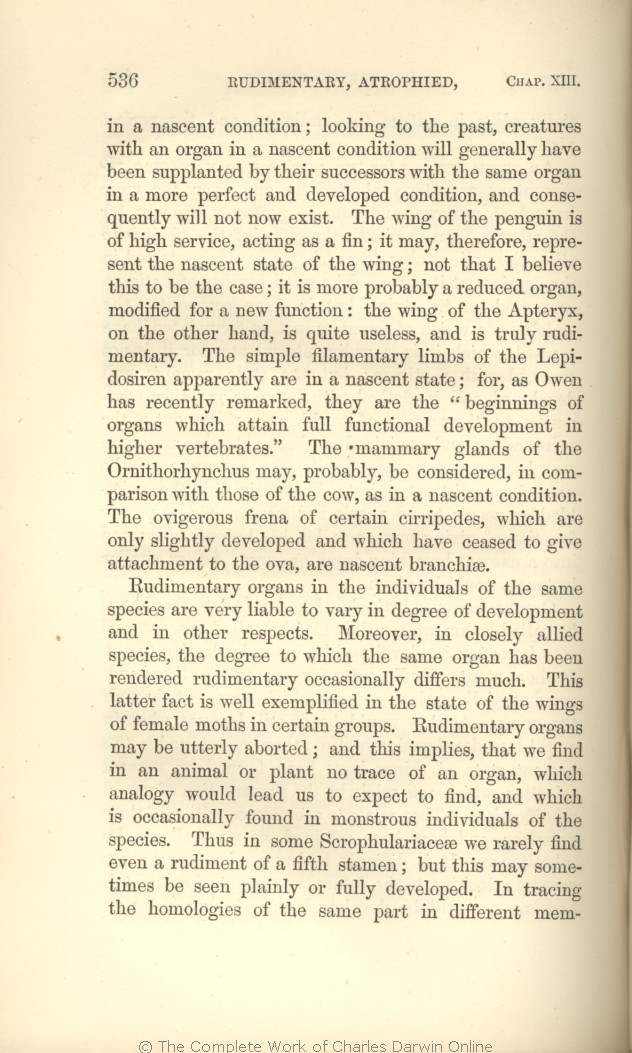condition will
generally | generally 1860 1861 1866 1869 |
| always be somewhat rare; for beings thus provided will commonly 1872 |
| ..... 1866 1869 1872 | | and exterminated 1860 1861 |
| same organ 1866 1869 1872 | | organ 1860 1861 |
| and developed condition, and consequently will not now exist. 1866 |
| and developed condition. 1860 1861 |
| state, and consequently will have become long ago extinct. 1869 1872 |
| acting 1866 1869 1872 | | and acts 1860 1861 |
| wing; 1866 1869 1872 | | wings 1860 1861 |
| ..... 1866 1869 1872 | | of birds; 1860 1861 |
| case; 1861 1866 1869 1872 | | case, 1860 |
| function: 1860 1861 1866 1869 | | function; 1872 |
| Apteryx, 1866 1869 1872 | | Apteryx 1860 1861 |
| on the other hand, is quite 1866 1869 1872 |
| is 1860 1861 |
| recently remarked, 1866 | | remarked, 1869 |
| 1 blocks not present in 1859 1860 1861 1866 1869; present in 1872 | | Owen considers the simple filamentary limbs of the Lepidosiren as the "beginnings of organs which attain full functional development in higher vertebrates;" but, according to the view lately advocated by Dr. Günther, they are probably remnants, consisting of the persistent axis of a fin, with the lateral rays or branches aborted.
|
| glands 1860 1861 1866 1869 | | glans 1872 |
| Ornithorhynchus 1860 1861 1866 1872 | | Ornitho-rhynchus 1869 |
| may, 1860 1861 1866 | | may 1869 1872 |
| probably, 1866 | | perhaps, 1860 1861 | probably, 1869 1872 |
| those of the 1866 |
| the udder of a 1860 1861 |
| the udders of a 1869 1872 |
| condition. 1866 1869 1872 | | state. 1860 1861 |
| are only slightly developed and which 1860 1861 1866 1869 |
| OMIT 1872 |
| ova, 1860 1861 1866 1869 | | ova 1872 |
| are 1860 1861 1866 1869 |
| and are feebly developed, are 1872 |
| in the individuals of the same species 1860 1861 1866 1872 |
| OMIT 1869 |
| degree of 1860 1861 1866 |
| the degree of their 1872 |
| OMIT 1869 |
| respects. 1860 1861 1866 1872 |
| respects in the individuals of the same species. 1869 |
| Moreover, in 1860 1861 1866 1869 | | In 1872 |
| the degree 1860 1861 1866 1869 |
| also, the extent 1872 |
| rendered rudimentary 1860 1861 1866 | | reduced 1869 1872 |
| of 1866 1872 | | of the 1859 1860 1861 | | in 1869 |
| in certain groups. 1859 1860 1861 1866 1869 |
| belonging to the same family. 1872 |
| we find in an 1859 1860 1861 1866 |
| in certain 1869 1872 |
| animal 1859 1860 1861 1866 | | animals 1869 1872 |
| plant 1859 1860 1861 1866 | | plants, 1869 1872 |
| no trace of an organ, 1859 1860 1861 1866 |
| parts are entirely absent 1869 1872 |
| find, 1859 1860 1861 1866 1869 | | find 1872 |
| and which is 1859 1860 1861 1866 |
| and which are 1869 |
| in them, and which are 1872 |
| individuals 1859 1860 1861 1866 | | individuals. 1869 1872 |
| of 1859 1860 1861 1866 | of 1869 1872 |
| the 1859 1860 1861 1866 | the 1869 1872 |
| species. 1859 1860 1861 1866 | species. 1869 1872 |
| some Scrophulariaceæ we rarely find even a rudiment of a 1866 |
| the snapdragon (antirrhinum) we generally do not find a rudiment of a 1859 1860 1861 |
| most of the Scrophulariaceæ the 1869 1872 |
| stamen; 1859 1860 1861 1866 | | stamen 1869 1872 |
| but this may sometimes 1859 1860 1861 1866 |
| is utterly aborted; yet we may conclude that a fifth stamen once existed, for a rudiment of it is found in many species of the family, and this rudiment occasionally becomes perfectly developed, as may 1869 |
| is utterly aborted; yet we may conclude that a fifth stamen once existed, for a rudiment of it is found in many species of the family, and this rudiment occasionally becomes perfectly developed, as may sometimes 1872 |
| seen plainly or fully developed. 1866 |
| seen. 1859 1860 1861 |
| seen in the common snap-dragon. 1869 1872 |
| the same 1859 1860 1861 1866 | | any 1869 1872 |
| mem- bers 1866 | | members 1859 1860 1861 1869 1872 |
|









